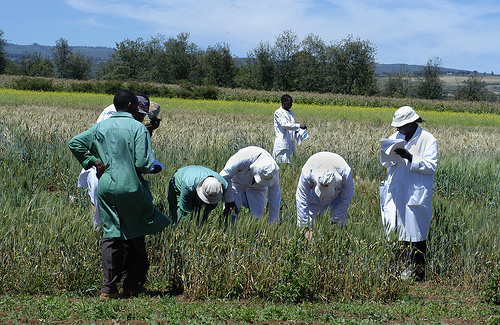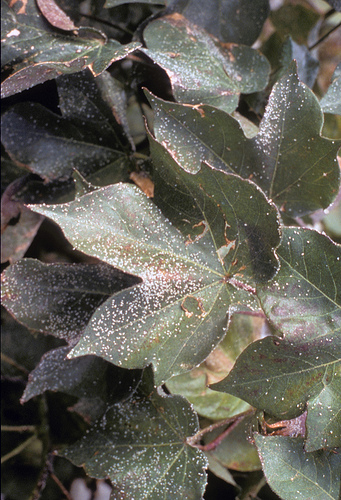
Agriculture Secretary Tom Vilsack tours Renmatix's state-of-the-art bioindustrial facility at Renmatix headquarters in King of Prussia, PA on Friday, Jan. 11, 2013, and to commission the company’s new multiple-feedstock processing BioFlex Conversion Unit. Photo property of Renmatix.
If you want proof that rural America is a land of limitless opportunity, go to King of Prussia, Pennsylvania.
Last week I accompanied Secretary Vilsack as he toured a state-of-the-art bioindustrial facility in Pennsylvania that converts multiple feedstocks into cellulosic sugars. The plant, operated by Renmatix, will test and convert a range of non-food plant materials through a proprietary process. The goal is to move forward in development of next-generation renewable energy and high value bio-based alternatives to petroleum-based products. It is a goal that bears enormous promise for rural America, potentially creating many thousands of jobs, untold economic activity and new markets. Read more »
Tags: ARS, bio-based economy, biofuels, FAA, Kansas State University, Navy, Pennsylvania, Renewable Energy, Tom Vilsack, Utah
 Economic Growth, Energy
Economic Growth, Energy

Mosquito on human skin.
USDA is taking its battle against bad bugs “to the streets.” USDA’s Agriculture Research Service (USDA-ARS) is seeking public input in fighting insect pests, many of whom may, in public opinion, top the lists as public nuisance number one—like bedbugs and mosquitoes. Read more »
This post is part of the Science Tuesday feature series on the USDA blog. Check back each week as we showcase stories and news from the USDA’s rich science and research portfolio.
An international team of scientists, including some from USDA’s Agricultural Research Service, has identified the 90,000-plus genes that make up the wheat genome. This was a monumental task, considering that the wheat genome is five times the size of the human genome.
Why does this matter? Wheat is one of the world’s “big three” crops, along with rice and corn, and unlocking its secrets will help researchers develop an overall picture of the plant’s genetic makeup and broaden their understanding of how genetics and environment determine a crop’s health and viability. Why is one variety of wheat susceptible to drought or a particular disease, but not another? Why does one variety grow well in one type of soil, but not another? The genome map will help scientists find those answers by making it easier to link specific genes with important traits and develop genetic markers that can lead to breeding of new wheat varieties that produce higher yields and better tolerate drought, diseases and pests. Read more »

Researchers in Njoro, Kenya, evaluating wheat for resistance to Ug99 in October 2005.
The Journal Nature today published a paper reporting that scientists from USDA’s Agricultural Research Service (ARS), as part of an international team, have completed a shotgun sequencing of the wheat genome. The achievement is expected to increase wheat yields, help feed the world and speed up development of wheat varieties with enhanced nutritional value. Wheat is one of the world’s “big three” crops, along with rice and corn, upon which the world’s growing population depends for nutrition.
Sequencing the genome of wheat was unusually daunting because the wheat genome is five times the size of the human genome, and has 94,000 to 96,000 genes. This sequencing effort involved the identification of essentially all of those genes and mapping their relationship to other genes. Previously, the size and complexity of the wheat genome had been significant barriers to performing a complete analysis, but the scientists overcame that problem by developing a new strategy that compared wheat genetic sequences to known grass genes, such as from rice and barley. Read more »

The Beltsville Small White turkey, developed by USDA scientists in the 1930s, met the American homemaker’s needs and secured turkey’s starring role on holiday tables
This post is part of the Science Today feature series on the USDA blog. Check back each week as we showcase stories and news from USDA’s rich science and research portfolio.
When you sit down to your Thanksgiving feast and reflect on the bounty on your table, you might want to say a quiet “thank you” to the agricultural researchers who have made your holiday favorites so plentiful and so good for you, too.
Let’s start with the Thanksgiving star: the turkey. This Native American bird was rapidly slipping in popularity in the 1930s because smaller family size and smaller iceboxes meant there were too many unwieldy leftovers from the big birds. Read more »

ARS studies have shown that there are effective alternatives to conventional broad-spectrum pesticides for fighting sweet potato whiteflies on cotton plants.
This post is part of the Science Tuesday feature series on the USDA blog. Check back each week as we showcase stories and news from USDA’s rich science and research portfolio.
Some Arizona growers rely on broad-spectrum insecticides to treat whiteflies, but scientists with the USDA’s Agricultural Research Service (ARS) are studying the option of letting nature lend a hand in combating the costly pests. Read more »





